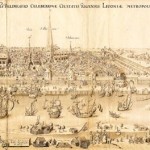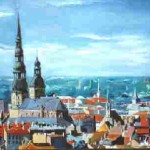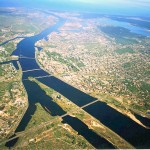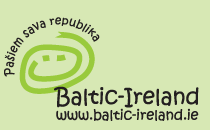Republic of Latvia



 Latvia (/ˈlætviə/) (historically Lettonia, or Lettland), officially the Republic of Latvia (Latvian: Latvija or Latvijas Republika), is a country in Northern Europe. Latvia shares land borders with Estonia to the north, Lithuania to the south — and both Russia and Belarus to the east. It is separated from Sweden in the west by the Baltic Sea. The capital of Latvia is Riga (Latvian: Rīga). Latvia has been a member state of the European Union since May 1, 2004 and a member of NATO since March 29, 2004.
Latvia (/ˈlætviə/) (historically Lettonia, or Lettland), officially the Republic of Latvia (Latvian: Latvija or Latvijas Republika), is a country in Northern Europe. Latvia shares land borders with Estonia to the north, Lithuania to the south — and both Russia and Belarus to the east. It is separated from Sweden in the west by the Baltic Sea. The capital of Latvia is Riga (Latvian: Rīga). Latvia has been a member state of the European Union since May 1, 2004 and a member of NATO since March 29, 2004.
History
The territory of Latvia has been populated since 9000 BC with the proto-Baltic ancestors of the Latvian people settling on the eastern coast of the Baltic Sea around the third millennium BC (3000 BC). By 900 AD, four Baltic tribal cultures had developed: Couronians, Latgallians, Selonians, Semigallians (in Latvian: kurši, latgaļi, sēļi and zemgaļi), as well as the Livonians (līvi) speaking a Finno-Ugric language.
Across Europe, Latvia’s coast was known for its amber. The ancient Balts traded Latvian amber with Ancient Greece and the Roman Empire. Even today it is frequently used in traditional Latvian jewellery.
At the end of the 12th century, traders from Western Europe often visited Latvia, setting out on trading journeys along Latvia’s longest river, the Daugava, to Russia.
 Christian missionaries arrived in 1180. As the Balts did not readily convert and strongly opposed the christening, German Crusaders were sent into Latvia to convert the pagan population. By 1211, Christianity had effective control with the foundation stone for the Dome Cathedral in Riga laid.
Christian missionaries arrived in 1180. As the Balts did not readily convert and strongly opposed the christening, German Crusaders were sent into Latvia to convert the pagan population. By 1211, Christianity had effective control with the foundation stone for the Dome Cathedral in Riga laid.
In the 1200s, a confederation of feudal nations called Livonia developed under German rule. Livonia included today’s Latvia and Southern Estonia. In 1282, Riga and later the cities of Cēsis, Limbaži, Koknese and Valmiera were included in the Hanseatic League. From this time, Riga became an important point in west-east trading. Riga, being the centre of the eastern Baltic region, formed close cultural contacts with Western Europe.
 The 1500s were a time of great changes for the inhabitants of Latvia, notable for the reformation and the collapse of the Livonian state. After the Livonian War (1558–1583) today’s Latvian territory came under Polish-Lithuanian rule. The Lutheran faith was accepted in Kurzeme, Zemgale and Vidzeme, but the Roman Catholic faith maintained its dominance in Latgale and continues to do so today.
The 1500s were a time of great changes for the inhabitants of Latvia, notable for the reformation and the collapse of the Livonian state. After the Livonian War (1558–1583) today’s Latvian territory came under Polish-Lithuanian rule. The Lutheran faith was accepted in Kurzeme, Zemgale and Vidzeme, but the Roman Catholic faith maintained its dominance in Latgale and continues to do so today.
In Colonial age Duke Jacob of Duchy of Courland colonised Gambia in wester Africa and Tobago in Caribbean. Later selling them to Great Britain.
The seventeenth and early eighteenth centuries saw a struggle between Poland, Sweden and Russia for supremacy in the eastern Baltic. Most of Polish Livonia, including Vidzeme, came under Swedish rule with the Truce of Altmark in 1629. Under the Swedish rule, serfdom was eased and a network of schools was established for the peasantry.
 The Treaty of Nystad ending the Great Northern War in 1721 gave Vidzeme to Russia (it became part of the Riga Governorate). The Latgale region remained part of Poland as Inflanty until 1772, when it was joined to Russia. The Duchy of Courland became a Russian province (the Courland Governorate) in 1795, bringing all of what is now Latvia into Imperial Russia.
The Treaty of Nystad ending the Great Northern War in 1721 gave Vidzeme to Russia (it became part of the Riga Governorate). The Latgale region remained part of Poland as Inflanty until 1772, when it was joined to Russia. The Duchy of Courland became a Russian province (the Courland Governorate) in 1795, bringing all of what is now Latvia into Imperial Russia.
The promises Peter the Great made to the Baltic German nobility at the fall of Riga in 1710, confirmed by the Treaty of Nystad and known as “the Capitulations,” largely reversed the Swedish reforms. The emancipation of the serfs took place in Courland in 1817 and in Vidzeme in 1819. In practice, the emancipation was actually advantageous to the nobility because it dispossessed the peasants of their land without compensation. The social structure changed dramatically, with a class of independent farmers establishing itself after reforms allowed the peasants to repurchase their land, landless peasants numbering 591 000 in 1897, a growing urban proletariat and an increasingly influential Latvian bourgeoisie. The Young Latvians (Latvian: Jaunlatvieši) movement laid the groundwork for nationalism from the middle of the century, many of its leaders looking to the Slavophiles for support against the prevailing German-dominated social order. Russification began in Latgale after the Polish led January Uprising in 1863 and spread to the rest of what is now Latvia by the 1880s. The Young Latvians were largely eclipsed by the New Current, a broad leftist social and political movement, in the 1890s. Popular discontent exploded in the 1905 Revolution, which took on a nationalist character in the Baltic provinces.
World War I devastated the country. Demands for self-determination were at first confined to autonomy, but full independence was proclaimed in Riga on November 18, 1918, by the People’s Council of Latvia, Kārlis Ulmanis becoming the head of the provisional government. The War of Independence that followed was a very chaotic period in Latvia’s history. By the spring of 1919 there were actually three governments — Ulmanis’ government; the Soviet Latvian government led by Pēteris Stučka, whose forces, supported by the Red Army, occupied almost all of the country; and the Baltic German government of “Baltic Duchy” headed by Andrievs Niedra and supported by Baltische Landeswehr and German Freikorps unit Iron Division. Estonian and Latvian forces defeated the Germans at the Battle of Cēsis in June 1919, and a massive attack by a German and Russian force under Pavel Bermondt-Avalov was repelled in November. Eastern Latvia was cleared of Red Army forces by Polish, Latvian, and German troops in early 1920.
 A freely elected Constituent Assembly was convened on May 1, 1920 and adopted a liberal constitution, the Satversme, in February 1922. This was partly suspended by Ulmanis after his coup in 1934, but reaffirmed in 1990. Since then it has been amended and is the constitution still in use in Latvia today. With most of Latvia’s industrial base evacuated to the interior of Russia in 1915, radical land reform was the central political question for the young state. In 1897, 61.2% of the rural population had been landless; by 1930 that percentage had been reduced to 23.2%. The extent of cultivated land surpassed the pre-war level already in 1923. Innovation and rising productivity led to rapid growth of economy, but it soon suffered the effects of the Great Depression. Though Latvia showed signs of economic recovery and the electorate had steadily moved toward the centre during the parliamentary period, Ulmanis staged a bloodless coup on May 15, 1934, establishing a nationalist dictatorship that lasted until 1940. Most of the Baltic Germans left Latvia by agreement between Ulmanis’ government and Nazi Germany after the conclusion of the Molotov-Ribbentrop Pact. On October 5, 1939, Latvia was forced to accept a “mutual assistance” pact with the Soviet Union, granting the Soviets the right to station 25,000 troops on Latvian territory. On June 16, 1940, Vyacheslav Molotov presented the Latvian representative in Moscow with an ultimatum accusing Latvia of violations of that pact, and on June 17 great numbers of Soviet forces occupied the country. Fraudulent elections for a “People’s Saeima” were held, and a puppet government headed by Augusts Kirhenšteins led Latvia into the USSR. The annexation was formalised on August 5, 1940.
A freely elected Constituent Assembly was convened on May 1, 1920 and adopted a liberal constitution, the Satversme, in February 1922. This was partly suspended by Ulmanis after his coup in 1934, but reaffirmed in 1990. Since then it has been amended and is the constitution still in use in Latvia today. With most of Latvia’s industrial base evacuated to the interior of Russia in 1915, radical land reform was the central political question for the young state. In 1897, 61.2% of the rural population had been landless; by 1930 that percentage had been reduced to 23.2%. The extent of cultivated land surpassed the pre-war level already in 1923. Innovation and rising productivity led to rapid growth of economy, but it soon suffered the effects of the Great Depression. Though Latvia showed signs of economic recovery and the electorate had steadily moved toward the centre during the parliamentary period, Ulmanis staged a bloodless coup on May 15, 1934, establishing a nationalist dictatorship that lasted until 1940. Most of the Baltic Germans left Latvia by agreement between Ulmanis’ government and Nazi Germany after the conclusion of the Molotov-Ribbentrop Pact. On October 5, 1939, Latvia was forced to accept a “mutual assistance” pact with the Soviet Union, granting the Soviets the right to station 25,000 troops on Latvian territory. On June 16, 1940, Vyacheslav Molotov presented the Latvian representative in Moscow with an ultimatum accusing Latvia of violations of that pact, and on June 17 great numbers of Soviet forces occupied the country. Fraudulent elections for a “People’s Saeima” were held, and a puppet government headed by Augusts Kirhenšteins led Latvia into the USSR. The annexation was formalised on August 5, 1940.
 The Soviets dealt harshly with their opponents — prior to the German invasion, in less than a year, at least 27,586 persons were arrested; most were deported, and about 945 persons were shot. While under German occupation, Latvia was administered as part of Reichskommissariat Ostland. Latvian paramilitary and Auxiliary Police units established by occupation authority actively participated in the Holocaust. More than 200,000 Latvian citizens died during World War II, including approximately 70,000 Latvian Jews murdered during the Nazi occupation. Latvian soldiers fought on both sides of the conflict, including in the Latvian Legion of the Waffen-SS, most of them conscripted by the occupying Nazi and Soviet authorities. Refusal to join the occupying army resulted in imprisonment, threats to relatives, or even death.
The Soviets dealt harshly with their opponents — prior to the German invasion, in less than a year, at least 27,586 persons were arrested; most were deported, and about 945 persons were shot. While under German occupation, Latvia was administered as part of Reichskommissariat Ostland. Latvian paramilitary and Auxiliary Police units established by occupation authority actively participated in the Holocaust. More than 200,000 Latvian citizens died during World War II, including approximately 70,000 Latvian Jews murdered during the Nazi occupation. Latvian soldiers fought on both sides of the conflict, including in the Latvian Legion of the Waffen-SS, most of them conscripted by the occupying Nazi and Soviet authorities. Refusal to join the occupying army resulted in imprisonment, threats to relatives, or even death.
The Soviets reoccupied the country in 1944–1945, and further mass deportations followed as the country was forcibly collectivised and Sovietised; 42,975 persons were deported in 1949. Influx of labourers, administrators, military personnel and their dependents from Russia and other Soviet republics started, and by 1959 the ethnic Latvian population had fallen to 62%. During the Khrushchev Thaw, attempts by national communists led by Eduards Berklavs to gain a degree of autonomy for the republic and protect the rapidly deteriorating position of the Latvian language were suppressed. In 1989 the Supreme Soviet of the USSR adopted a resolution on the “Occupation of the Baltic States,” in which it declared that the occupation was “not in accordance with law,” and not the “will of the Soviet people”. A national movement coalescing in the Popular Front of Latvia took advantage of glasnost under Mikhail Gorbachev, opposed by the Interfront. On May 4, 1990, the Supreme Soviet of the Latvian SSR adopted the Declaration of the Restoration of Independence of the Republic of Latvia, subject to a transition period that came to an end with Latvian independence on August 21, 1991, after the failure of the August Putsch. The Saeima, Latvia’s parliament, was again elected in 1993, and Russia completed its military withdrawal in 1994.
 The major goals of Latvia in the 1990s, to join NATO and the European Union, were achieved in 2004. Language and citizenship laws have been opposed by many Russophones, although a majority have now become citizens. (Citizenship was not automatically extended to former Soviet citizens who settled during the Soviet occupation or to their subsequent offspring. Children born to non-nationals after the reestablishment of independence are automatically entitled to citizenship.) The government denationalised private property confiscated by the Soviet rule, returning it or compensating the owners for it, and privatised most state-owned industries, reintroducing the prewar currency. After a difficult transition to a liberal economy and its re-orientation toward Western Europe, though its economy has one of the highest growth rates.
The major goals of Latvia in the 1990s, to join NATO and the European Union, were achieved in 2004. Language and citizenship laws have been opposed by many Russophones, although a majority have now become citizens. (Citizenship was not automatically extended to former Soviet citizens who settled during the Soviet occupation or to their subsequent offspring. Children born to non-nationals after the reestablishment of independence are automatically entitled to citizenship.) The government denationalised private property confiscated by the Soviet rule, returning it or compensating the owners for it, and privatised most state-owned industries, reintroducing the prewar currency. After a difficult transition to a liberal economy and its re-orientation toward Western Europe, though its economy has one of the highest growth rates.
reklāma: reklama@baltic-ireland.ie redakcija: info@baltic-ireland.ie







